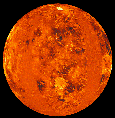A global view of the surface of Venus from Magellan.
Click on image for full size
NASA/JPL
An Overview of the Interior and Surface of Venus
Venus is the second planet from the Sun, and is Earth's neighbor in the
solar
system. Venus is the brightest object in the sky after the Sun
and the Moon, and sometimes looks like a
bright
star in the morning or evening sky.
We can't see the
surface of the planet
because it has a very thick atmosphere filled with clouds that
strongly reflect sunlight. Observations of Venus in the
ultraviolet show
cloud features that
relate to characteristics of the planet's atmosphere.
Venus is slightly smaller than Earth, and considering its neighboring
position in the solar system might be expected to be similar to Earth.
We think that the internal structure of
Venus is
similar to Earth, with a metallic core, rocky mantle, and crust.
The atmosphere of Venus produces
hostile conditions at the
planet's surface, where temperatures can reach more than 460C (900F),
atmospheric pressure is 90 times that at the Earth's surface, and
clouds filled with sulfuric acid surround
the planet.
Nonetheless, space missions
sent to Venus have managed to land on and photograph the surface while the
Magellan
spacecraft mapped the surface of the planet from above. These maps reveal a
surface covered with craters, over 1600 major volcanoes, mountains, large highland terrains, and
vast lava plains.
You might also be interested in:

What types of instructional experiences help K-8 students learn science with understanding? What do science educators teachers, teacher leaders, science specialists, professional development staff, curriculum designers, school administrators need to know to create and support such experiences?
...more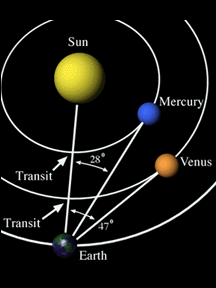
Venus and Mercury, the innermost planets in the solar system, always appear only a small distance away from the Sun in the sky. The maximum elongations (maximum angular distances between an inner planet
...more
This is a map of the surface of Venus (turned sideways!). Lowlands in the map are similar to an ocean bottom, and highlands resemble continents. As can be seen in the image, the surface of Venus consists
...more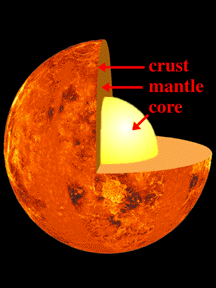
Venus is a slightly smaller than the Earth, with a diameter 95% that of Earth (12,103 km) and a mass 81% that of Earth. If we could walk around on the surface of the planet (without being killed by the
...more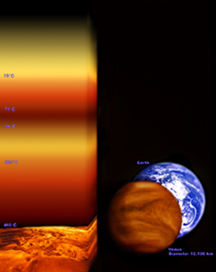
The atmosphere of Venus is very hot and thick. If you were on the surface of the planet, the air above you would be about 90 times heavier than the Earth's atmosphere. This is like what a submarine experiences
...more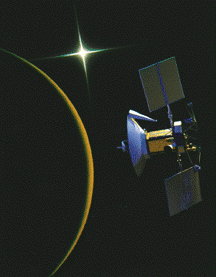
On May 4, 1989, Magellan, a spacecraft built mostly from spare parts from other missions, was carried into Earth orbit by the Atlantis space shuttle and launched toward Venus. It arrived on Aug. 10, 199
...more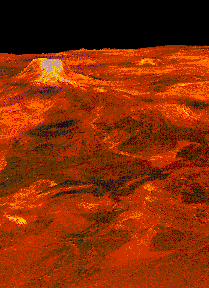
Volcanic rises are thought to form when a portion of the deep mantle is heated to several hundred degrees hotter than its surroundings. This portion of the mantle is now less dense than its surroundings
...more
This image clearly shows a channel where something once flowed. Without proper measurements, scientists can only guess what sort of liquid may have flowed through this channel. On Earth, such channels
...more


